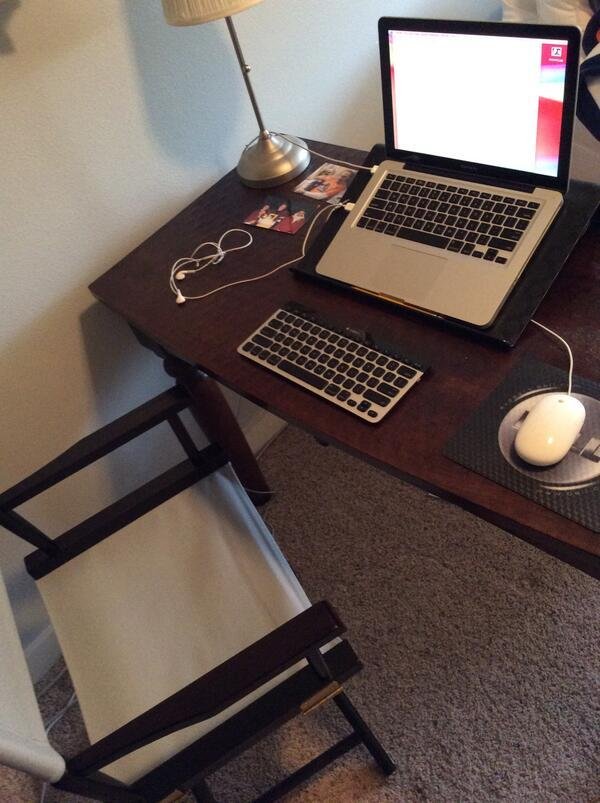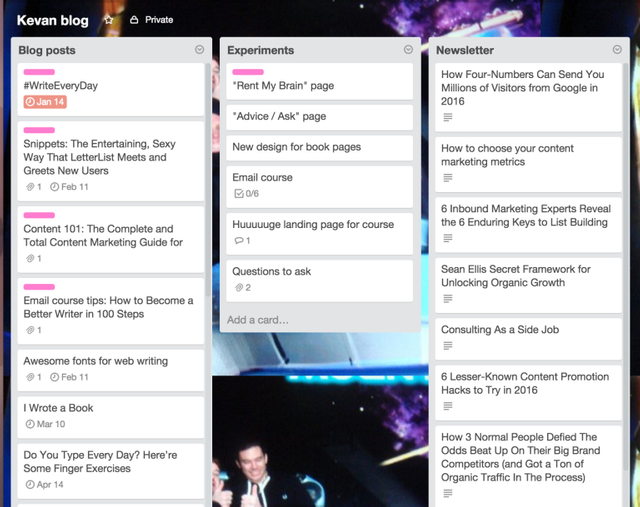
You are a comet streaking through the sky, a firework, a home run, a standing ovation inside a volcano. You are hope and faith and love and courage and everything good in the world.
You want to write every day?
Yes! Yes! Yes!

I’ve got just the seven-step writing course to get you going.
What a legendary cause to take up. Writing every day will be one of the most important resolutions you will ever make, whether you go on to write the next great American novel or the next lovely workplace email. You can absolutely do this. Know how I know?
You might already be doing it – what with tweeting, texting, and the like.Those are my favorite kind of resolutions!
Doing it lets you do all those other things you’ve been meaning to do, too. Like start a blog!
I do it. And I only complete about 10% of my resolutions (build an iPhone app? Getting there!)
Here’s how I’d like to help, mostly by getting out of your way and letting you do you.
Below you’ll find seven quick lessons on how to get into a writing habit.
Lesson 0: There’s no better time to start than right now. You don’t have to have it figured out. You don’t have to have a plan. Starting beats sitting any day of the week.

- Not now, ma! I’m cocooning!
Lesson 1: Build yourself a writing environment
Your body is uber smart. It recognizes the places we frequent, and our brains get into the mindset they’re trained to be in. If you always eat M&M’s when you’re at the kitchen counter, then guess what you’ll want to munch on when you go to the kitchen counter!
If you always write when you’re in the guest bedroom, laptop open, earphones in, lights dimmed low in the early morning hours and Adele streaming into your earbuds …
… then you’ve found your writing environment, your sweet spot, your cocoon!
Some cocoon elements:
Music: Yes or no? I have to have it quiet, ambient, or the type of music that I’ve heard a million times and doesn’t catch my attention any more.
A room with a view: Yes or no? Ernest Hemingway wrote staring into a dresser. I have a blank wall in front of my computer (and a beautiful window to my right).
Time of day: Are you a night owl or a morning lark? (I’m #teamlark.)
Light: Bright or dim? Maybe I’m weird, but on bright sunny days I write less and get headaches more. I need things dim or twilight-y (#teamedward). Flux helps, too.
Smell: Not sure on this one! Could the smell of a candle or fresh-baked cookies get your mind right for writing? I’ll investigate the cookie bit.
Here’s a picture of my cocoon:

I’d love to see yours!
- How to write 10,000 words per day
Lesson 2: Get scientific about things
Just to be clear: I don’t write 10,000 words per day.
But Rachel Aaron does!
She’s got a really neat (proven, for her) system of getting there, too. It’s all explained in her book 2k to 10k: Writing Faster, Writing Better, and Writing More of What You Love, which you can grab from the Kindle store. Super tip: Grab the free Kindle sample and you get the majority of the 10,000-word blueprint. And then totally buy the book afterward because you’ve just gained oh-so-much from these methods!
Basically, it works like this:
Know what you’re writing before you write it.
Dedicate 5 minutes to write out a quick description of what you’re going to write that day.
Measure your writing with a spreadsheet.
Note the time you start, the time you stop, how many words, and where you were physically in the world when you were writing (in your cocoon, maybe?). After two weeks, sit down with your data and look for patterns.
![]()
(Here’s a free spreadsheet sample.)
Have a candy bar per day (not a literal candy bar)
“Candy bar content” is the stuff you’re most excited about writing. Make sure you have something to look forward to writing each day! Write it first to get in the groove.
Again, it’s all in Rachel’s book. Thank you, Rachel! I owe you!
- Get yourself a side blog
Lesson 3: Get a home for your writing
Not everyone has the luxury of needing to write four 1,500-word blog posts a week for their job (that makes the #WriteEveryDay challenge pretty easy, right?).
If you don’t have a daily, prolific blogging task, you can create one of your own and do the thing our forefathers fought and died for: so that everyone could have a blog.
Seriously though, get yourself a blog! A blog about anything, absolutely positively anything you want. A blog that you can experiment with. Mess around with headlines. Blow an hour-and-a-half on the blog theme and design. Use it as your personal sandbox and playground, and then get cracking on some awesome content.
A blog seem too daunting?
Try Medium, which is a) beautiful, b) free, and c) has a built-in audience of 1000s of eyeballs.
Send me a link when you’re all set up!
- Write every day, but not every day
Step 4: Go easy on yourself
This might sound odd: One of the keys to writing every day is to not feel like you have to write every day.
There it is, cat’s outta the bag!
Here’s me with a new resolution: Start on Wednesday, nail it Thursday, nail it Friday, forget on Saturday, guilt on Sunday, completely off the rails Monday.
Weekends and life intervene. And the thing is, it’s a lot easier to set up writing as part of your routine if you have a consistent routine Monday through Friday (and anarchy and naps on the weekends).
So cut yourself some slack. Skip the weekends if you want.
- Stop writing in the middle of a senten– (and other writer’s block tips)
Lesson 5: Good advice from great writers
Ernest Hemingway has this great and specific tip for avoiding writer’s block:
The best way is always to stop when you are going good and when you know what will happen next. If you do that every day … you will never be stuck.
Always stop while you are going good and don’t think about it or worry about it until you start to write the next day. That way your subconscious will work on it all the time.
tl;dr – stop in the middle of a sentence!
That’s a super practical one, and there’s also some great tidbits from other writers on the whole idea of writer’s block, which is either a myth or a misunderstanding.
Philip Pullman:
Plumbers don’t get plumber’s block, and doctors don’t get doctor’s block; why should writers be the only profession that gives a special name to the difficulty of working, and then expects sympathy for it?
Anne Lamott:
Annie Dillard has said that day by day you have to give the work before you all the best stuff you have, not saving up for later projects. If you give freely, there will always be more. This is a radical proposition that runs so contrary to human nature, or at least to my nature, that I personally keep trying to find loopholes in it. But it is only when I go ahead and decide to shoot my literary, creative wad on a daily basis that I get any sense of full presence, of being Zorba the Greek at the keyboard. Otherwise, I am a wired little rodent squirreling things away, hoarding and worrying about supply.
The word “block” suggests that you are constipated or stuck, when the truth is that you’re empty.
And failing these tips, there’s always this methodology of Gertrude Stein’s, explained in the book Daily Rituals:
The two ladies drive around in their Ford till they come to a good spot. Then Miss Stein gets out and sits on a campstool with pencil and pad, and Miss Toklas fearlessly switches a cow into her line of vision. If the cow doesn’t seem to fit in with Miss Stein’s mood, the ladies get into the car and drive on to another cow. When the great lady has an inspiration, she writes quickly, for about fifteen minutes. But often she just sits there, looking at cows and not turning a wheel.
When was the last time a cow fit your mood? :)
P.S. There’s also this tongue-in-cheek list of solutions.
- Tweeting is writing
Step 6 – Let’s talk about social media
There’s this really interesting book called Microstyle (recap here) that goes into detail on all the little things about words, names, taglines, jingles, etc. Tweets, too! And you can’t help but finish the book and think to yourself: Wow, tweeting is artful writing!
Tweeting is writing.
Facebooking is writing.
Instagramming is writing.
It’s all writing, right?
That’s one of the things I love most about this #WriteEveryDay challenge. Chances are, most folks might already be doing it!
If you share to social media in any way at all, that’s writing. So if you’re ever on the cusp of losing your writing momentum, remind yourself that all those tweets and FBs are writing. Sometimes, they’re the hardest type of writing(!): the type that requires thought and focus and just the write word and phrasing.
If all you’ve got the capacity for is writing 140 characters, no worries. Take some inspiration from this guide on syntax to try something new.
No one ever said that writing every day needed to be 1,000 words (unless that was your specific goal, in which case, you could write 36 tweets?).
btw, what’s your Twitter handle? I’d love to follow!
- The Swipe File
Step 7: Always have something to write next
So … what to write?
Pretty much anything you choose to write will be worthwhile, even if it ends up never seeing the light of day: a discarded draft, an unfinished novel, a book of poetry you feel weird showing anyone else.
The goal is to write and to exercise that writing muscle so that six months from now when your fingers are spinning gold you’ll be able to turn back and look upon that poetry book with much respect for helping you get where you are.
That being said, sometimes I’m not sure what to write next.
So I’ve made a swipe file.
A swipe file is a collection of random thoughts and ideas of things I find interesting, fun, unique, brave, confusing, inspiring, etc.
I store all my stuff in Trello where someday – maybe, maybe not – it will end up being a real live thing I write.

(feel free to borrow any idea there – I’d love to see what you do with it!)
Over to you
What writing goals have you set for the year? Where will you be writing?
By Kevin Lee
@demphil
With more upvote
Okay, I went into your piece thinking 'if you want to write every day, write" but when I read it I think you made some pretty good suggestions that may help people get started. Good job.
Downvoting a post can decrease pending rewards and make it less visible. Common reasons:
Submit